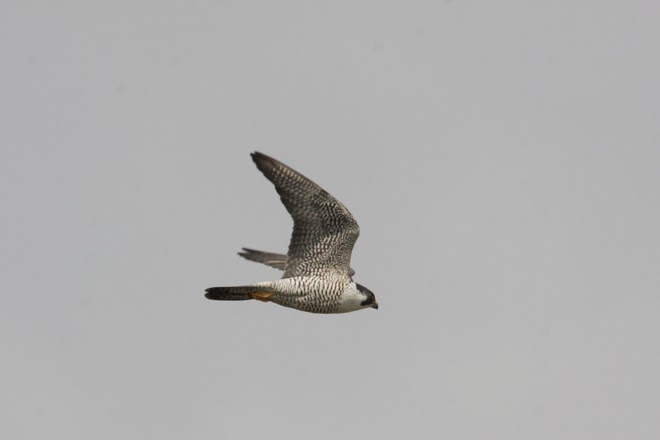A spring migrant at Uchiyama, Tsushima. The very worn tail suggests it had a tight roost spot during winter.
Amur Falcon appears to be at best a very scarce autumn visitor which could turn up almost anywhere along the Japan Sea, though presumably the odds of running into one will decrease further north in Honshu. The bird in the digiscoped image below is one I found on Hegurajima which might be expected insomuch as it appears Japanese birders are on the look out for it there. Despite that, this is the only bird that's been seen there during time I've spent on the island in October, now totalling several weeks over the years, which maybe says something as to its status in central Japan.
This bird spent 3-4 hours on the island allowing everyone present to catch up with it.
Merlin is a regular wintering species in the region, not uncommon but they cover a large area and can be difficult to find, especially over the vast expanse of fields near Lake Biwa. They are often easier to see at Ogura which is a much smaller area.
Female type Merlin, Hegurajima.
Male, Ogura. This tree afforded an excellent view of the fields and was used by Merlins year after year but was felled in 2013.
Northern Hobby is a scarce migrant through the area, and one I'm yet to catch up with around Kyoto. The closest place I've seen them is Cape Irago just outside the region and they are fairly regular on Hegurajima in October.
Adult on Hegurajima in October.
Juvenile on Hegurajima in October 2014.
Gyr Falcon is very much a Hokkaido speciallity and irregular even there. I haven't heard of any in Kansai, certainly not while I've been living here, but I did see a grey morph on Hegurajima which is a pretty amazing record!
Peregrine is an altogether easier proposition, they're common in winter and a regular breeder in the region. They can be seen in open country or urban areas.
Birds come to bathe on the Yamato River in Osaka.
Over the Yamato River, Osaka.
A juvenile calling to an adult (no relation as far as I'm aware) with prey on Hegurajima.
Juvenile Peregrine, Hegura.
The two shots above are of a tiny (presumed 2CY) on Ishigaki, Yaeyama Islands in April 2013. The wires the provide a sense of scale, it looks more like a Merlin than a Peregrine. Contrast this with the heavily marked monster of a bird on Tsushima, Nagasaki in May 2012. There's no way this one's going to balance on the wires.



















No comments:
Post a Comment